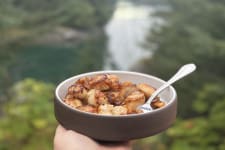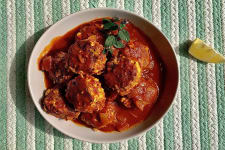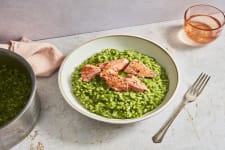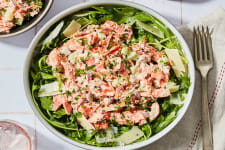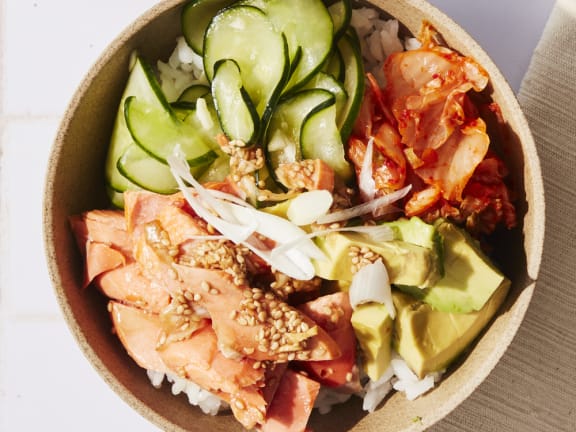
Perfect Cold Lunch Ideas for the Warmer Months
May 29th, 2020Refreshing Meal Inspiration for Spring and Summer
Just because your lunch is going to be a cold one doesn’t mean it has to be less satisfying than a meal made or microwaved to order. Wild Alaskan fish is a versatile protein to integrate into a variety of cold lunches, easily transforming last night’s dinner into a completely new series of dishes. But you don’t have to wait to have leftovers. Some of these recipes cater to your cravings for uniquely cold dishes like a tangy ceviche or an easy fish salad bound together with an addictively delicious mayo.
Here’s cold lunch inspo that will effortlessly keep wild Alaskan fish on your lunch rotation, keeping you cool in the kitchen. Whether you’re heading to work, packing up picnic, or fantasizing about when you can send your kids back to school, these cold lunches will be ready to go wherever the day takes you:
Expand Your At-Home Salad Bar
Not only is this macaroni salad from Food & Wine a perfect option for cold lunch. And because you’re using smoked salmon, it’s practically a no-cook recipe — all you need to do is boil water, then combine the rest. However, if you’ve got leftovers of a cooked fillet, feel free to use that instead of smoked salmon; just break it up into bite-sized pieces, and you’re good to go.
A grilled fillet from the night before is the perfect ingredient to make into a mayo-based salad for a sandwich. Think tuna salad, but fancier. We recommend following Bon Appétit’s lead and dressing up your regular mayo into something spicy to mix into whatever fish you have on hand. Then, slather a thick layer of it onto your favorite bread and eat now or later.
This halibut and chickpea salad from Giada de Laurentis can be served with fish straight off the grill, at your leisure at room temperature, or cold the next day. The combination of halibut and chickpeas makes this a healthy, protein-rich, filling lunch. Just hold the dressing until you’re ready to eat so that the lettuce stays crisp.
No Cutlery Required
A buttery fillet of ceviched * black cod is the star of this twist on a spring roll from Martha Stewart. There’s actually nothing about this “spring roll” that is remotely authentic, but it’s legit the perfect mashup of some of our favorite culinary elements: ceviched fish, lettuce wraps, and zero-cooking. All you need is some low-maintenance patience, and you’ve got a cold lunch you can eat when you’re chillin’ on a hot day.
There really aren’t any rules when it comes to onigiri, the cute and compact Japanese rice balls that are composed, simply, of rice, nori, and a filling of your choice. You can put whatever ingredients you like into them and they travel well as lunch or an afternoon snack. Leftovers that have been prepared with a miso glaze like this one from Serious Eats pair up nicely with sesame and seaweed, but don’t be discouraged from filling your onigiri with chopped up spot prawns or tidbits blackened pollock. Check out Just One Cookbook’s basic tutorial on how to make onigiri and let your palette dictate the rest.
Lunch in a Fish Bowl
Poke bowls ** are ridiculously easy to make at home when you have high-quality wild Alaskan salmon on hand. Check out our recipe for a classic take on a poke bowl with wild salmon.
A hearty grain like rye berries or farro can be made in big batches and dished out over the course of the week to become a hearty grain bowl, a blank canvas for a cold lunch. This recipe from Edible Seattle uses smoked salmon as its star, but you can easily adapt this recipe to your liking by subbing out the smoked salmon for flaked cod or rockfish.
Vietnamese inspired noodle bowls with rice vermicelli noodles are so simple to put together, showcasing the clean flavors of herbs, the sweet and tart umami bomb of nuoc cham, and whatever protein you feel like serving on top. Grilled spot prawns are an obvious choice for this one, and can be served straight off the fire or for a decadent cold lunch the next day.
* Though the fish in ceviche is “cooked” by acid, it is still considered a raw form of seafood. Officially, we cannot recommend that you eat our salmon raw; and are required to inform you that consuming raw or undercooked seafood and shellfish may increase your risk of foodborne illness. There's a physiological change that wild salmon experience when they move from fresh water to salt water (and back again), which makes them more susceptible to parasites found in fresh water. While we follow modern flash-freezing processes that help to kill off the parasites, we definitely recommend cooking our salmon before eating it. Here's an article with a few more details on our thoughts behind this.
** Please keep the above note in mind for poke, too.
